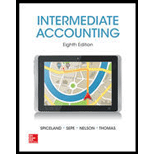
Concept explainers
1.
Net Operating Loss Carryforward
The net operating loss is considered as negative taxable income. When the tax-deductible expenses exceed the taxable revenues, the net operating loss is carry forwarded as it helps in getting deductions in future taxable amount.
Deferred tax is an amount i.e. computed on the basis of tax liability on the income as per income statement and the income as per tax return, that difference is known as deferred tax. Deferred tax amount is deferred to the next financial year.
When the Income Tax Expense account is more than the Income Tax Payable account, this difference is known as Deferred Tax Asset.
When the Income Tax Expense account is less than the Income Tax Payable account, this difference is known as Deferred Tax Liability.
To prepare: The
2.
To show: The lower portion of 2016’s income statement that reports the income tax benefit of the net operating loss.
Want to see the full answer?
Check out a sample textbook solution
Chapter 16 Solutions
INTERMEDIATE ACCOUNTING
- What is the overall contribution margin ratio?arrow_forwardWestlake Components planned to use $95 of material per unit but actually used $92 of material per unit. The company planned to produce 1,800 units but actually produced 1,400 units. What is the sales-volume variance?arrow_forwardPlease provide the answer to this general accounting question with proper steps.arrow_forward
- Navarro Enterprises has a beginning retained earnings balance of $78,000. Net income for the year is $22,000, and cash dividends paid during the year amount to $12,500. What will be the ending retained earnings balance? a. $78,000 b. $87,500 c. $100,000 d. $65,500arrow_forwardDetermine the pre-paid insurance value for portman enterprises as this is the one unknown item.arrow_forwardCornell Corporation plans to generate $960,000 of sales revenue if a capital project is implemented. Assuming a 30% tax rate, the sales revenue should be reflected in the analysis by:arrow_forward
- Your factory produces 165 electric bicycles per month. Direct costs are $1,890 per bicycle. The monthly overhead is $92,400. What is the average cost per electric bicycle with overhead?arrow_forwardHow does principle-based accounting differ from rule-based systems? (a) Detailed regulations cover every situation (b) Strict numerical thresholds determine all treatments (c) Professional judgment guides decisions rather than strict rules (d) Standard formulas solve all problems. MCQarrow_forwardI need help with this financial accounting question using standard accounting techniques.arrow_forward
- Please provide the solution to this general accounting question using proper accounting principles.arrow_forwardPlease explain the correct approach for solving this general accounting question.arrow_forwardPlease explain the correct approach for solving this general accounting question.arrow_forward

 AccountingAccountingISBN:9781337272094Author:WARREN, Carl S., Reeve, James M., Duchac, Jonathan E.Publisher:Cengage Learning,
AccountingAccountingISBN:9781337272094Author:WARREN, Carl S., Reeve, James M., Duchac, Jonathan E.Publisher:Cengage Learning, Accounting Information SystemsAccountingISBN:9781337619202Author:Hall, James A.Publisher:Cengage Learning,
Accounting Information SystemsAccountingISBN:9781337619202Author:Hall, James A.Publisher:Cengage Learning, Horngren's Cost Accounting: A Managerial Emphasis...AccountingISBN:9780134475585Author:Srikant M. Datar, Madhav V. RajanPublisher:PEARSON
Horngren's Cost Accounting: A Managerial Emphasis...AccountingISBN:9780134475585Author:Srikant M. Datar, Madhav V. RajanPublisher:PEARSON Intermediate AccountingAccountingISBN:9781259722660Author:J. David Spiceland, Mark W. Nelson, Wayne M ThomasPublisher:McGraw-Hill Education
Intermediate AccountingAccountingISBN:9781259722660Author:J. David Spiceland, Mark W. Nelson, Wayne M ThomasPublisher:McGraw-Hill Education Financial and Managerial AccountingAccountingISBN:9781259726705Author:John J Wild, Ken W. Shaw, Barbara Chiappetta Fundamental Accounting PrinciplesPublisher:McGraw-Hill Education
Financial and Managerial AccountingAccountingISBN:9781259726705Author:John J Wild, Ken W. Shaw, Barbara Chiappetta Fundamental Accounting PrinciplesPublisher:McGraw-Hill Education





